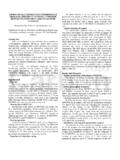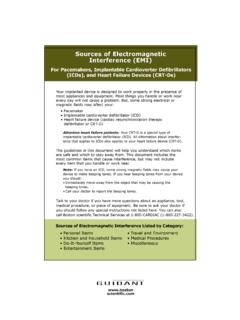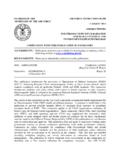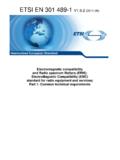Transcription of Transmission Line EMF Interference with Buried Pipeline ...
1 Proceedings of the International Conference on Non-Ionizing Radiation at UNITEN (ICNIR 2003) electromagnetic Fields and Our Health 20th 22nd October 2003 1 Transmission line EMF Interference with Buried Pipeline : Essential & Cautions M. H. Shwehdi and U. M. Johar Electrical Engineering Department at King Fahd University of Petroleum & Minerals, Dhahran, Saudi Arabia ABSTRACT Transmission lines are considered one of the major sources of magnetic field. In recent years electromagnetic field (EMF) Interference with Buried pipelines has been of great interest in the literature. The EMF Interference on pipelines located in utility corridors is a real and serious problem which can place both operator safety and Pipeline integrity at risk. Installing pipelines in energy utility corridors containing high-voltage AC Transmission lines subjects the pipelines to induced AC voltages.
2 This can be caused by an imbalance in the Transmission system, and by high voltages near Transmission tower grounding systems resulting from lightning strikes and phase faults. When a long-term induced AC voltage exists on a Pipeline , it can be dangerous and potentially life-threatening for operations personnel to touch the Pipeline or appurtenances. In addition, pipe corrosion also can result from AC discharge. Due to the wide lands of Saudi Arabia and its long water and oil pipelines, a considerable length of these pipelines extends along the high voltage Transmission lines right-of-way. A study was conducted in 1992 in the Eastern region to evaluate such AC voltages deposited on Buried oil pipelines from the utility Transmission lines. As well as in 1998 another investigation was conducted on a 380 KV Transmission line and a parallel Buried water Pipeline in the West region.
3 To address this problem, the pipelines must be grounded with a system that passes AC, but blocks DC, to both mitigate the AC and maintain the cathodic protection system on the Pipeline . The paper presents the essential procedures, guidelines, needed data and cautions when conducting such evaluations. Also, it presents the results of a case study of a 380 KV Transmission line in the Eastern region of Saudi Arabia. KEYWORDS electromagnetic Field, EMF Interference , Pipelines, EMF Interference Investigation, Transmission Lines Interference Proceedings of the International Conference on Non-Ionizing Radiation at UNITEN (ICNIR 2003) electromagnetic Fields and Our Health 20th 22nd October 2003 2 INTRODUCTION The problem of EMF Interference on Buried pipelines has been known for well over 30 years.
4 However, the problem has gained widespread recognition only in the last 10 years due to improvements in Pipeline technology and the increased tendency to locate pipelines in utility right-of-way (ROW) near high-voltage electric Transmission lines. Pipelines are now frequently being installed in electric power Transmission right-of-ways (ROW). Installation of pipelines which are considered as electric conductors near high voltage Transmission lines can result in unusual Pipeline /EMF Interference problems. When steel pipelines are installed close to overhead electric Transmission lines, Interference can occur between the electric lines fields and the Pipeline , as seen in figure Electric power is transmitted in three phase systems and on one or double circuit structure; each carried on a separate line held aloft by pylons or towers along the right of way.
5 Figure Influence by inductive coupling The voltage sequence of the power is sinusoidal AC power phase and is 120 out of phase with the other two. If each phase is equal, the sum of the alternating currents in the three phases and the sum of the magnetic fields resulting from the alternating current in each phase should add up to zero in balanced three phase system. Figure illustrates that the different distances between the Pipeline and each phase in the Transmission line , along with phase imbalance, lead to induced AC Interference on the Pipeline [1-2]. Proceedings of the International Conference on Non-Ionizing Radiation at UNITEN (ICNIR 2003) electromagnetic Fields and Our Health 20th 22nd October 2003 3 Figure Induction Affect and Different distances between the Pipeline and the Transmission line circuit Coatings on pipelines are usually used to avoid and protect pipelines from the severe corrosive effects due to the harsh environment in Saudi Arabia.
6 Modern Pipeline coating technology has exacerbated the AC mitigation problem by creating better coatings, leaving fewer defects in the coating for AC to go to ground. In fact, a bare Pipeline would be a good answer to the induced AC problem. Both the Fusion Bonded Epoxy coatings used in the and Three Layer FBE/PE coatings used in Europe have made the problem of AC Interference on pipelines more severe. In the past, less well coated pipelines had sufficient grounding, such that induced voltages were not a practical problem. The rapid expansion of Transmission lines, industrial plants and remote resources of discovered oil field as well as the limited water resources in Saudi Arabia dictates the delivery of such commodities to its ports and locations [3-4].
7 This means the addition of more Buried Pipeline routs to maintain services, life and development in Saudi Arabia. The continuous up grade of such services, corrosive climate requires cathodic protection (CP) to be implemented. This will make EMI evaluation studies a vital one to assure that (CP) is actively operative and above all the electromagnetic field Interference (EMI) studies are needed for the safety of personal and assets. BACKGROUND EMF Interference between Transmission systems and Buried pipelines can be of three kinds: A. Electrostatic or capacitive Interference : Occurs in the immediate vicinity of the overhead power lines when the pipe is laid on a foundation that is well insulated from the ground. The Pipeline picks up a voltage relative to the soil, which is proportional to the voltage in the Transmission line .
8 Welded pipe lengths near high voltage lines must be grounded when the nominal voltage in the overhead lines exceeds 115 kV and the length of the welded section exceeds more than a few hundred feet to 1,000 ft. Electrostatic coupling is of minor consequence after construction, since even the best pipe coating will allow sufficient leakage to earth, through defects, to effectively ground the electrostatic charge [5-6]. B. Resistive or ohmic Interference : Proceedings of the International Conference on Non-Ionizing Radiation at UNITEN (ICNIR 2003) electromagnetic Fields and Our Health 20th 22nd October 2003 4 Occur when lightning strikes a Transmission structure, or when there is a phase-ground fault. When this occurs, a large voltage cone is created around the pylon grounding system.
9 If a Pipeline is located within this area, voltage can get onto the Pipeline in the area within the voltage cone through coating defects. Anyone touching the Pipeline outside the voltage cone could receive a shock from the potential between the Pipeline and the surrounding soil. Protective measures for people are required if the contact voltage exceeds 65 V for long-term Interference , or 1,000 V for short-term Interference . These measures include wearing rubber boots, insulated gloves, or insulated protective padding. On no account, however, can there be any direct bond between the Pipeline and the pylon grounding system [6-7]. Special conditions arise if the Pipeline is laid in the vicinity of a power station ground system or a transformer installation.
10 If a lasting or transitory connection with the grounding installation results during a grounding fault, the grounding voltage will be transferred to the Pipeline and appear outside the voltage cone as a contact voltage. Depending on the Pipeline and its coating, the contact voltage decreases more or less quickly at greater distances. C. electromagnetic or inductive Interference : Occurs when there is extended and close parallel routing with three-phase high voltage AC Transmission lines. The voltage is due to any phase imbalance in the lines. The likelihood of Interference increases with rising operating currents in the overhead lines, with increasing quality of the coating on the Pipeline , and with the length of line parallel to and close to the high voltage AC (HVAC) Transmission lines.

















